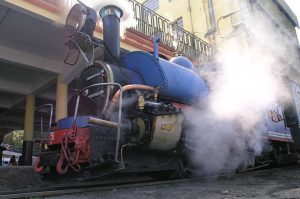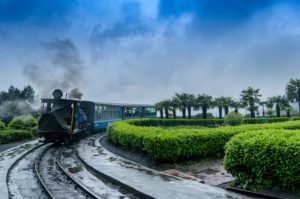Darjeeling Himalayan Railway Restoration: The Darjeeling Himalayan Railway (DHR), fondly referred to as the “Toy Train”, is set to embark on a transformative journey aimed at restoring its past splendor and cultural significance. This narrow-gauge marvel, which has charmed generations of travelers with its rhythmic chugging, steep gradients, and picturesque hill views, is not merely a mode of transport—it is a living, breathing monument to India’s colonial history, engineering prowess, and mountain culture. As the DHR undergoes a large-scale restoration initiative, spearheaded by the Indian Railways in partnership with UNESCO and other heritage conservation agencies, the primary goal is to revitalize this historic rail line both structurally and aesthetically, ensuring it remains a global heritage attraction.
This comprehensive restoration project is not only about repairing decaying infrastructure but also about reinvigorating the essence of the railway, which continues to be a symbol of the region’s identity and pride. Built between 1879 and 1881 during British rule, the DHR has stood the test of time, enduring landslides, earthquakes, and modernization pressures. Its unique blend of Victorian-era railway technology and Himalayan landscapes has captivated tourists from across the world, making it one of the most iconic narrow-gauge railways on the planet. However, decades of wear and tear, coupled with challenges like climate change, environmental degradation, and urban encroachment, have posed serious threats to its longevity.
Recognizing the urgent need for conservation, the authorities have launched a multi-phased project that not only aims to restore the physical infrastructure—including tracks, stations, and steam engines—but also to preserve the cultural and emotional legacy of the Toy Train. The effort includes historically accurate renovations of the Darjeeling Station, revitalization of the surrounding areas, modernization of facilities for better tourist experience, and community engagement to ensure that the local population becomes an integral part of the preservation process.
In short, this initiative is far more than just a facelift; it is a strategic and heartfelt attempt to breathe new life into a national treasure. By fusing heritage conservation with sustainable tourism and modern accessibility, the project hopes to transform the Darjeeling Himalayan Railway into a globally recognized model of how traditional infrastructure can be protected and promoted in the 21st century. The DHR is not just on track for repair—it is on track for revival, promising a future where history, culture, and engineering coalesce in the most scenic train ride India has to offer.
A Glimpse into the Past: The Legacy of Darjeeling Station
Established in the year 1881, during the height of the British colonial era, Darjeeling Railway Station stands as a remarkable testament to both the engineering ingenuity and strategic foresight of that period. Nestled in the heart of the Eastern Himalayas, this historic station was constructed as the upper terminus of the Darjeeling Himalayan Railway (DHR)—a narrow-gauge rail line designed to connect the mountainous town of Darjeeling with the bustling commercial hub of Siliguri on the plains below. Its development was a feat of logistical planning and architectural brilliance, especially considering the extremely challenging terrain, steep gradients, and unpredictable climatic conditions of the region.
The station was part of a larger vision by the British to make hill stations more accessible for administrative, commercial, and recreational purposes. Darjeeling, with its temperate climate, lush tea gardens, and panoramic views of the Kanchenjunga range, had quickly become a favored retreat for British officials escaping the heat of the Indian summer. The DHR—and by extension the Darjeeling Station—was pivotal in transforming this sleepy Himalayan town into one of the most important hill stations in colonial India.
One of the station’s most defining characteristics lies in its narrow-gauge tracks, measuring just two feet (610 mm). This unconventional gauge was selected to allow the railway to wind its way through sharp curves, steep ascents, and densely populated areas, often sharing space with roads and markets—a rarity in railway design. The accompanying steam locomotives, some of which are still operational today, became synonymous with the “Toy Train” experience. These iron giants, puffing along the ridgelines and valleys, carried not just passengers but also the colonial ambitions of the British Raj.
The architectural design of the Darjeeling Station is another enduring legacy. The station blends traditional hill architecture with functional Victorian aesthetics, using stone masonry, timber trusses, sloping roofs, and arched porticos that reflect both climatic considerations and British stylistic preferences of the time. Even today, the building evokes an unmistakable sense of nostalgia, transporting visitors to an era where train travel was considered a grand adventure. Inside, vintage signage, antique ticket counters, and old-world benches serve as a living museum for railway enthusiasts and history lovers alike.
Beyond its physical structure, the Darjeeling Station also holds immense cultural and emotional significance for the people of the region. For generations, it has served as a gateway to opportunities, a lifeline during emergencies, and a symbol of local pride. Children wave at the passing trains; shopkeepers along the tracks build their day around its timetable; and tourists from across the globe come to witness its timeless charm.
Over the years, the station has also been featured in numerous films, documentaries, and literary works, further embedding it into the cultural fabric of India. Its cinematic presence in movies like Barfi! and Parineeta has helped revive interest in heritage railways, while academic studies on British transport policies often cite the DHR as a model of sustainable hill transportation.
However, with the passage of time and the pressures of modernization, the once-pristine condition of Darjeeling Station has visibly deteriorated. Crumbling platforms, decaying signage, overgrown vegetation, and infrastructural fatigue have all contributed to a gradual decline. This decline has been a cause for concern not just among conservationists but also among residents and tourists, who fear that an irreplaceable piece of living history may be lost forever if urgent action is not taken.
Fortunately, the recent push for restoration aims to reverse this trend. With the spotlight back on the Darjeeling Station as part of the broader Darjeeling Himalayan Railway revitalization plan, stakeholders are determined to restore the station to its former glory. The goal is to make it more than just a functioning transport hub—it must once again become a symbol of heritage, resilience, and timeless elegance.
In sum, the Darjeeling Station is far more than a stop along the Toy Train route—it is a monument to the past, a relic of colonial ambition, and a beacon of cultural identity for the hills of West Bengal. Its legacy, steeped in history and emotion, continues to chug forward, carrying the weight of memory and the promise of preservation.
Darjeeling Himalayan Railway Restoration: UNESCO Recognition and the Imperative for Preservation
In 1999, UNESCO designated the DHR as a World Heritage Site, acknowledging its outstanding universal value. This recognition underscores the railway’s significance in showcasing innovative transportation solutions in challenging terrains. However, the heritage status also brings the responsibility of maintaining and preserving the site’s integrity.


Challenges Faced: The Need for Restoration
Over the years, the Darjeeling Station and the DHR have faced numerous challenges, including natural disasters like landslides and earthquakes, which have damaged infrastructure. Urban encroachment, inadequate maintenance, and environmental degradation have further threatened the railway’s condition. These issues have prompted UNESCO to express concerns about the site’s preservation, emphasizing the urgency for restoration efforts.
The Restoration Initiative: Reviving the Past
The restoration project aims to rejuvenate the Darjeeling Station and the DHR by addressing structural damages, restoring historical features, and enhancing facilities for passengers. Key aspects of the initiative include:
- Infrastructure Rehabilitation: Repairing tracks, bridges, and station buildings to ensure safety and functionality.
- Heritage Conservation: Preserving architectural elements and historical artifacts to maintain the site’s authenticity.
- Community Engagement: Involving local communities in the restoration process to foster a sense of ownership and promote sustainable tourism.
Collaborative Efforts: Partnerships and Funding
The restoration project is a collaborative endeavor involving the Indian Railways, UNESCO, and various stakeholders. A significant development was the signing of a fund-in-trust agreement worth over $500,000 to support the Comprehensive Conservation Management Plan (CCMP) for the DHR. This plan outlines strategies for effective conservation, management, and promotion of the railway.
Anticipated Outcomes: A Revitalized Heritage Experience
The successful restoration of the Darjeeling Station and the DHR is expected to yield multiple benefits:
- Enhanced Tourism: A restored railway will attract more tourists, boosting the local economy.
- Cultural Preservation: Maintaining the railway’s historical elements will preserve cultural heritage for future generations.
- Educational Opportunities: The project can serve as a case study for heritage conservation and sustainable tourism practices.
Darjeeling Himalayan Railway Restoration: A Journey Towards Preservation


The restoration of the Darjeeling Station and the DHR is more than a structural overhaul; it’s a commitment to preserving a vital piece of India’s history. By addressing the challenges and implementing comprehensive conservation strategies, this initiative aims to ensure that the “Toy Train” continues to enchant passengers and stand as a symbol of heritage and resilience.
For more details please follow the below links:
- UNESCO World Heritage Centre – Mountain Railways of India
- Darjeeling Himalayan Railway Society (DHRS)
- Darjeeling Himalayan Railway – Official Website
- UNESCO – Technical Assistance for the Management of the DHR
Also read: Home | Channel 6 Network – Latest News, Breaking Updates: Politics, Business, Tech & More


